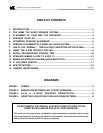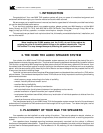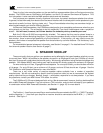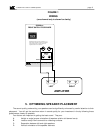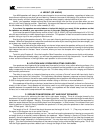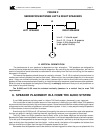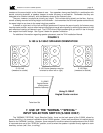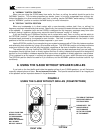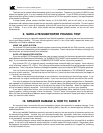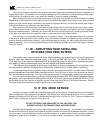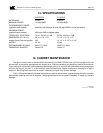
S-5000THX & S-150THX satellite speakers
page 6
A. HEIGHT (OR ANGLE)
Your M&K speakers will always deliver sound superior to conventional speakers, regardless of where you
locate them or where you are when you are listening. However, because of their design, they achieve their very
best sound quality and their flattest frequency response when properly oriented relative to your ear.
Ideally, your speakers' tweeters should be at the same height from the floor as your ears when you are
sitting in your main listening position. Specifically, this means the distance from the floor to the space between
the two tweeters (S-5000) or to the center tweeter (S-150).
If you have the speakers mounted above or below this height, you must tilt the speakers so that
the tweeters are aimed at your ears when you are in the main listening position.
If you have the special Angled Center version of the S-150 (S-150AC), its front baffle has a built-in "tilt" that
aims the sound either up or down depending on orientation. This speaker is ideal for use as the center channel
speaker sitting on top of a rear-projection television set.
Start by aligning the speakers visually. Sit in your main listening position and look at the cabinets' tops and
bottoms. When their perspective is about the same relative to where you are sitting (about the same angle), you
are at least very close to the proper alignment.
The best way to determine the proper angle is to have a helper move the speakers while you sit and listen.
You should be able to hear the difference when the speakers are in the best location by listening for the brightest
high frequencies and for the best "focus" of sound, where you hear the sharpest sonic imaging of voices and
instruments.
To do this, play Chapters 8 - 10 on the Lucasfilm "Wow" Laserdisc, or any other source of pink or white noise.
When the speakers are aimed properly, you will hear the greatest amount of high frequencies. You will be able
to hear a distinct difference in the highs when each speaker is at the correct angle.
B. LOCATION AWAY FROM REFLECTING SURFACES
Your speakers should generally be located away from walls, furniture, or any other reflecting surfaces. Any
object located close to the speaker will reflect the sound radiated from the speaker to your ear with a slight time
delay compared to the direct sound reaching your ear. This time delay will blur the sonic imaging and interfere
with transient performance.
The delay is very slight, so instead of hearing an echo, you hear a "blurred" sound with less clarity that is
not as sharp and distinct as it should be. This time delay also affects frequency response and sonic imaging.
Bear in mind, however, that while many satellite speakers do not perform well when placed on the floor, the
S-5000 is designed to deliver good performance whether sitting on the floor or mounted above it.
If the speakers will be sitting on shelves, locate them on the front edge of the shelf, so there is no flat surface
directly in front of them. If any speaker will sit close to a wall or any other large object, leave as much space as
possible between the speaker and the object. Ideally, your speakers will be located away from the nearest
surface, but in most rooms compromise will be necessary.
C. SEPARATION BETWEEN LEFT AND RIGHT SPEAKERS
Here is a formula for achieving the ideal left to right stereo imaging. Think of a triangle formed by the
locations of the left and right speakers and your listening position. Ideally, the subtended angle formed should
be between 45 and 50 degrees. Roughly, this means that the left and right speakers should be separated by
about the same distance that you are sitting back from the speakers. In other words, if the distance from your
listening position to the point directly between the speakers is 10 feet, place the speakers so their centers are
about 10 feet apart. See Figure 2.
The length of line A - B should be about the same as the length of line X - Y. (They may not seem to be
the same in this diagram due to an optical illusion).
Try to follow the formula as close as you can. You can fine tune the placement by listening to a source with
an image (such as a vocalist) centered between the speakers. When listening in stereo (no Center Channel
speaker), move the speakers closer together or farther apart in small increments until you hear the sharpest and
most cohesive image, especially in the phantom center. You may also want to angle (or "toe-in") the speakers
slightly. This often improves the sharpness of the stereo image, and provides a wider seating area. The S-150
Left and Right speakers provide a default toe-in through the angle of their front baffles.




